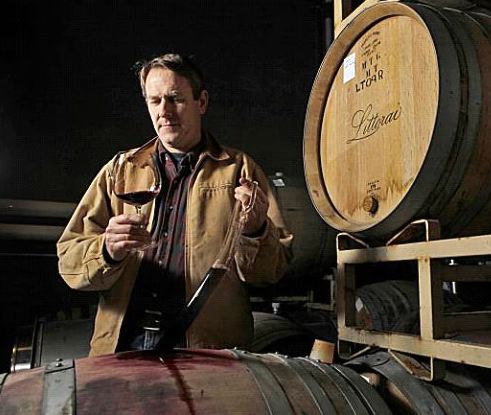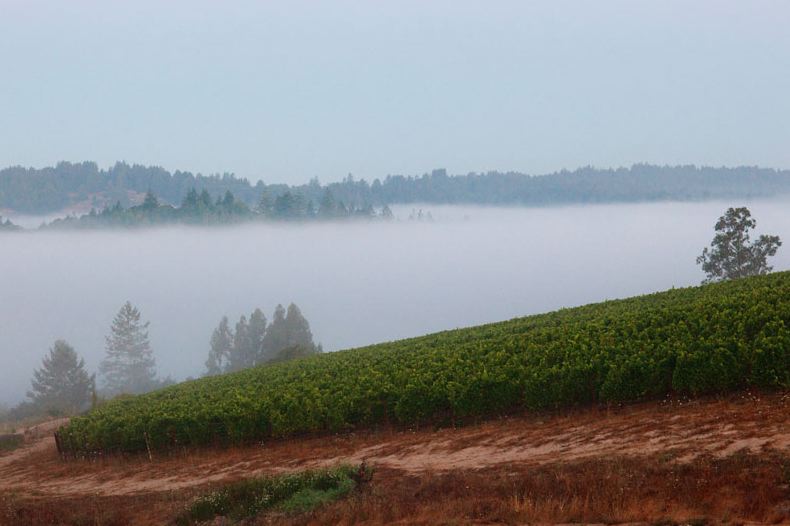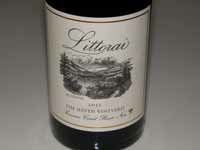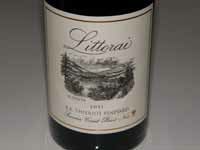Littorai: Balance & Harmony is Theme
It was 1997 and my love affair with Pinot Noir had just been rocked by the news that Williams Selyem was
being sold. To borrow from the words to the song, “American Pie”:
A long long time ago
I can still remember how
That Pinot used to make me smile
And I knew if Burt had the chance
That he could make those people dance
And maybe they’d be happy for a while
But 1997 made me shiver
With every Pinot I’d deliver
I couldn’t take one more step
But something touched me deep inside
The day the Pinot died
It was a good friend, Master Sommelier René Chazottes, who saved my passion. I was lamenting to René
about my loss when he related this endorsement to me in his understated way, “There is this winemaker
named Ted Lemon who was trained in Burgundy, is very talented, and makes good wine. You might check out
his wines.”
I headed straight for a local restaurant that had Ted’s Littorai wines on the wine list and ordered the 1992
Thieriot Sonoma Coast Pinot Noir. The wine was an epiphany, a revelation, love at first sip. The wine had the
elegance, purity and balance that I had come to enjoy in a Williams Selyem wine, but the wine had its own
character, a beautiful marriage of classic Old World Burgundy and New World flair. Littorai Pinot Noir quickly
became the yardstick that I used to judge all other North American Pinot Noirs against. Although I have sought
balance and harmony elsewhere and found it in a number of wines, I have always returned to Littorai as the
standard.

Ted’s story has been elucidated in detail in past issues of the PinotFile, but I will briefly note the high points
here. In the mid 1980s, he returned to the United States from his winemaking tour at Domaine Guy Roulot in
Meursault (Ted remains the only American ever to be the winemaker and vineyard manager at a major
domaine in Burgundy’s history), and was hired by a French family to be the founding winemaker and vineyard
manager for Chateau Woltner on Howell Mountain. The winery’s Chardonnays soon became a favorite among
American wine connoisseurs.
Once Ted’s winemaking and vineyardist skills were assured, he founded Littorai Wines in 1993. Ted believed
the finest Pinot Noir and Chardonnay were grown along the true littoral (Latin for coastal) zone of the continent.
He was convinced that the geology and mesoclimates of the extreme portion of the continent north of San
Francisco were diverse enough to create a series of unique terroirs and his conviction has since been
confirmed.
Ted was one of the first winegrowers who believed world class wine production could be achieved in California
using low yields, proper clones, vertical trellising, leaf removal, and other now commonly used viticultural
practices. He was the first to create “by-the-acre” contracts for wine grapes in which he personally and closely
supervised all aspects of vineyard management. This type of contract is now the norm for premium Pinot Noir
growers in California and Oregon.
Ted was the first to vineyard designate Savoy Vineyard, Mays Canyon Vineyard and Charles Heintz Vineyard.
He had a lengthy relationship with Summa Vineyard that was absolved through vineyard ownership change in
recent years, and has enjoyed long-term committed relationships with Cerise Vineyard, One Acre Vineyard
(part of Savoy’s Deer Meadow Ranch), Roman Vineyard, Hirsch Vineyard and B.A. Thieriot Vineyard. In
addition, Littorai has developed estate vineyards including Pivot (pictured below), The Haven and The
Tributary.
Practically all Littorai’s vineyard sources are farmed organically and more than half are farmed biodynamically
which Ted embraces wholeheartedly. He believes the clearest path to achieve wines of classic balance in
California’s dry summers is biodynamics. “We can produce vines which express the year and yet overcome its
greatest challenges, all in a self sustained, self contained model.”
Ted’s winemaking emphasizes minimal intervention and gentle handling of the fruit and wine. The Pinot Noir
wines are fermented in traditional open-top fermenters and at least some proportion of whole clusters are used.
All the wines undergo native yeast fermentation and complete malolactic fermentation, as long as nature does
not dictate otherwise. The goal (and what I find most appealing) is to avoid overripe flavors and high alcohol
levels, and focus on finesse, balance and length. Usually one-third to one-half new French oak is used for
aging the wines as an element of complexity, but one is never led to think of oak when tasting a Littorai wine.
Littorai wines can age extremely well and I would suggest that if you ever find older vintages of Littorai Pinot
Noir and Chardonnay in the secondary market, buy them. Ted says the 2000, 2002 and 2007 Pinot Noir
vintages are drinking beautifully now
A functional, but not extravagant winery was completed on the Littorai estate in time for the 2008 vintage. The
winery is a straw bale walled building constructed on two levels on the side of a hill and is where Ted and his
staff receives visitors. Visitors are offered both current releases and library wines for tasting. The intimate
tasting experience is available by appointment only, Monday through Saturday, for a small charge. Phone
707-823-9586 or visit the website at www.littorai.com for appointment information.
Littorai wines are available exclusively through a mailing list and fine restaurant placement throughout the
United States. The wines often sell out quickly and are sold on a first-come, first-served basis. Wines can be
picked up at the annual fall open house in October or shipped to your address.
If you only splurge on one ultra-premium California Pinot Noir producer each year, Littorai should be a top
consideration. Ted is a life long winemaker passionately committed to his craft. He did not come into wine as a
second career. His wines adhere to a personal esthetic sensibility and his impressive track record of
consistent excellence with multiple vineyard sources spans twenty years.
Ted described the 2011 vintage as follows. First, the good news: “A classic terroir driven vintage with each
vineyard displaying its traditional personality. This is a vintage where you can trust in the character of place.
The wines possess density, structure and acidity wrapped in a dark, woodsy and earthy bouquet. The vintage
will age very well so hold the 2011s for at least three to five years if you can manage it!” Now the bad news:
“2011 vineyard designated Pinot Noir production is the lowest since 2005.”
The winter 2011 releases included the 2012 Sonoma Coast Vin Gris of Pinot Noir, and the 2012 Sonoma Coast
and Les Larmes Anderson Valley appellation Pinot Noirs. The 2011 single vineyard releases include Pinot
Noir from Cerise Vineyard, Savoy Vineyard, One Acre Vineyard and Roman Vineyard in the Anderson Valley,
Hirsch Vineyard, The Haven Vineyard, Pivot Vineyard, Platt Vineyard, and B.A. Thieriot Vineyard in the
Sonoma Coast, and Mays Canyon Vineyard in the Russian River Valley. The following reviews are from a few
of the wines that I tasted recently. Still very young, the aromas literally jumped out of the glass when tasted a
day after opening. All the wines displayed spectacular elegance, freshness and transparency.
2011 Littorai Savoy Vineyard Anderson Valley Pinot Noir
13.9% alc., $65.
·
Moderately light reddish-purple
color in the glass. Welcoming scent of cherry, earthy flora, spice and balsam. Very elegant and demure, yet
flavorful, with tastes of strawberry, cherry, and spice on the mid palate, and some rose water and spiced
maraschino cherry on the bright finish. Very soft in the mouth with a subtle oak sheen and gossamer tannins.
The most forward and feminine of the wines tasted here, but like red lingerie, delicate yet alluring.
Score: 90
2011 Littorai Roman Vineyard Anderson Valley Pinot Noir
12-year-old vines farmed biodynamically since
2008. 13.1% alc., $65.
·
Moderate reddish-purple color in the glass. Soaring scents of black cherry, exotic
flowers, and oak spice. Haunting, deep cherry and berry flavors with hints of spice, white pepper and vanilla.
More body, power and length than the Savoy bottling, with a tannic structure that enhances the fruit, yet the
wine is still perceived as elegant. A David Bowie wine that is neither masculine or feminine.
Score: 92

2011 Littorai The Haven Estate Bottled Sonoma Coast Pinot Noir
13.3% alc., $80.
·
This is a wine that will make you sit up in your chair.
The darkest wine of those tasted here with a moderately dark reddish-purple
hue in the glass. The nose offers brooding aromas of black
cherries, black raspberries, black currant, seasoned oak and forest
floor. Delicious, round, polished and sassy with plenty of enticing sappy
dark red and black fruit. The velvety mouth feel is quite sensual and
the juicy finish leaves the hair stand up on your nape. Terrific the next
day from a previously opened and re-corked bottle.
Score: 94

2011 Littorai B.A. Thieriot Vineyard Sonoma Coast Pinot Noir
12.9% alc., $75.
·
Medium reddish-purple color in the glass. The
chameleon of a nose unfolds slowly offering a wide array of aromas
including black cherry pie glaze, black raspberry jam, tea leaf, smoked
bacon, and exotic spices. Quite reserved, offering its charms slowly
over time in the glass to reveal a hearty core of black berry and stone
fruit flavors enhanced by subtle oak notes. The dry tannins tend to
dominate at this young age, but I can see through that as I have drank
plenty of bottles of Thieriot Pinot Noir. The big, lengthy peacock finish elevates
this wine to another level. In the words of Jan McInerney, “I’m obsessed, crazed
with lust, spending ridiculous amounts of money on the object of my desire. Because when she’s good, she’s
very, very good.”
Score: 95
I tried a little experiment at the end of my tasting, but Ted, who is a firm proponent of terroir will cringe, so don’t
tell him about my experiment in terroir (or was it terror?). Wine is supposed to be fun, right? I mixed equal
small parts of each of the above four wines just to see what would result. The blend exhibited satisfying black
cherry, black raspberry and oak spice aromas. It was very tasty on the palate with impressive fullness and
displayed the full spectrum of dark red and black fruit. The problem was that it tasted muddled, uniform, even
corporate. The wine was very pleasant but not distinctive and any nuances were blurred. I clearly preferred
the vineyard designated bottlings for their complexity and individuality. Don’t try this experiment at home.






